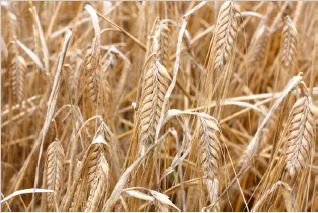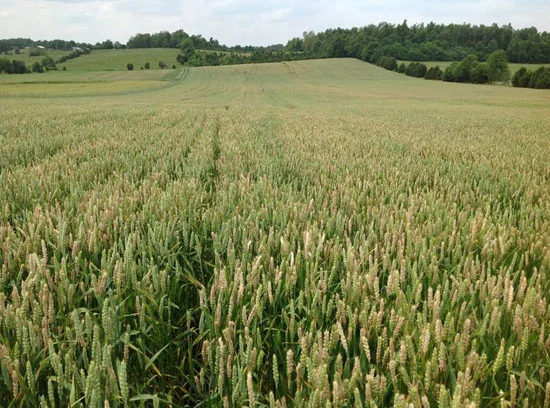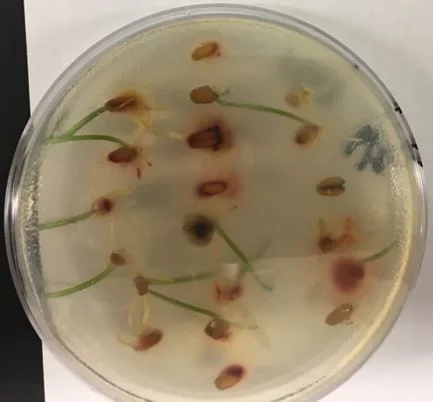In 2017 two separate populations of Italian ryegrass from Kentucky were submitted to the University of Kentucky weed science program for screening of herbicide resistance. The two populations were screened for resistance in greenhouses at the University of Kentucky Research and Education Center in Princeton in the winter of 2017-2018.
Read MoreBarley yellow dwarf is one of the most devastating diseases in wheat worldwide. Here, we report the absence and presence of plants infected with BYDV or CYDV in commercial wheat fields in western Kentucky.
Read MoreCommercial winter wheat seed (cv Pioneer26R1A) without and with insecticide seed treatment (Poncho® (clothianidin)) were planted into no-till research plots of the University of Kentucky’s Research and Education Center in Princeton, KY.
Read MoreResearch by Tim Phillips at University of Kentucky.
Read MoreCereal rye is planted on more acres than any other cover crop species in the U.S. because it can reliably produce substantial biomass in a wide range of growing conditions. In order to maximize these benefits, well-adapted cereal rye cultivars should be selected for rapid and complete ground cover, high biomass production, and high potential to suppress weeds.
Read MoreAs interest continues to grow in locally produced ingredients from the craft brewing industry in the mid-Atlantic and eastern U.S. finding malted barley is not easy for those located east of the Mississippi river. Therefore, the program’s main effort is breeding winter malting barley cultivars that have superior malt quality and are well adapted to the mid-Atlantic and southeastern United States.
Read MoreAnnual ryegrass has been chosen as the central focus of the greenhouse and field research due its notable advantages and the compelling proof of its effectiveness. Annual ryegrass roots apparently contain exudates that have a degrading effect on the fragipan. The deep root penetration also increases soil porosity and may facilitate the leaching of the 4 or 5 other effective compounds down to the fragipan. We are presently looking for varieties of annual ryegrass that are more effective in breaking down the fragipan and varieties that are more easily killed by glyphosate.
Read MoreThe overall objective of the research trials were to develop the best recommendations for managing Fusarium head blight (FHB; also known as scab) and the associated mycotoxin deoxynivalenol (DON; also known as vomitoxin) with foliar fungicides.
Read MoreRye as a grain crop has a potential local market with distilleries. Rye has not been grown in Kentucky since the 1920’s. We have been conducting research for several years on growing rye for grain. In the 2019 harvest season, we established rye at Princeton and Lexington to test several management hypotheses and fungicide efficacy against the Fusuriaum head blight (FHB).
Read MoreStagonospora leaf blotch is one of the most common foliar diseases observed in Kentucky. When flag leaves are affected by leaf blotch, yield losses generally occur. Glume blotch also is a common disease in Kentucky, and can reduce yields and test weight. One of the most common ways to manage these diseases is through application of foliar fungicides.
Read MoreThis work is intended to answer the question: Are there long term soil health benefits to having wheat in Kentucky farmers’ crop rotation? Comparing wheat harvested for yield to wheat (or other small grain) as a cover crop, is it better for the soil to take wheat to grain harvest?
Read MoreSpecialty small grains (e.g., cereal rye, hard red winter wheat, and malting barley) are a vital input into products like artisan bread, craft beer, and bourbon. Therefore, there are potential opportunities for Kentucky farmers to supply various specialty small grains to support the expansion in these markets.
Read MoreCurrent agronomic practices to reduce vomitoxin levels include planting moderately resistant wheat cultivars and fungicide applications at beginning flowering (Feekes 10.5.1 growth stage). This project is examining whether additional agronomic practices may potentially lower vomitoxin levels.
Read MoreCrossing: We produced a total of 550 crosses in the greenhouse this season. We made both single cross hybrids between 2 parental lines (138) and 3-way crosses (412) where the hybrid is crossed to a third parent.
Read More














